Owners of large dogs are often concerned about how long their canine companions can comfortably hold their pee. Understanding a dog’s capacity to control their bladder is not only essential for the animal’s comfort but also for ensuring a healthy routine and avoiding accidents at home. Large dogs generally have larger bladders, which means they can hold more urine; however, their ability to hold it is influenced by various factors, including age, size, and health.
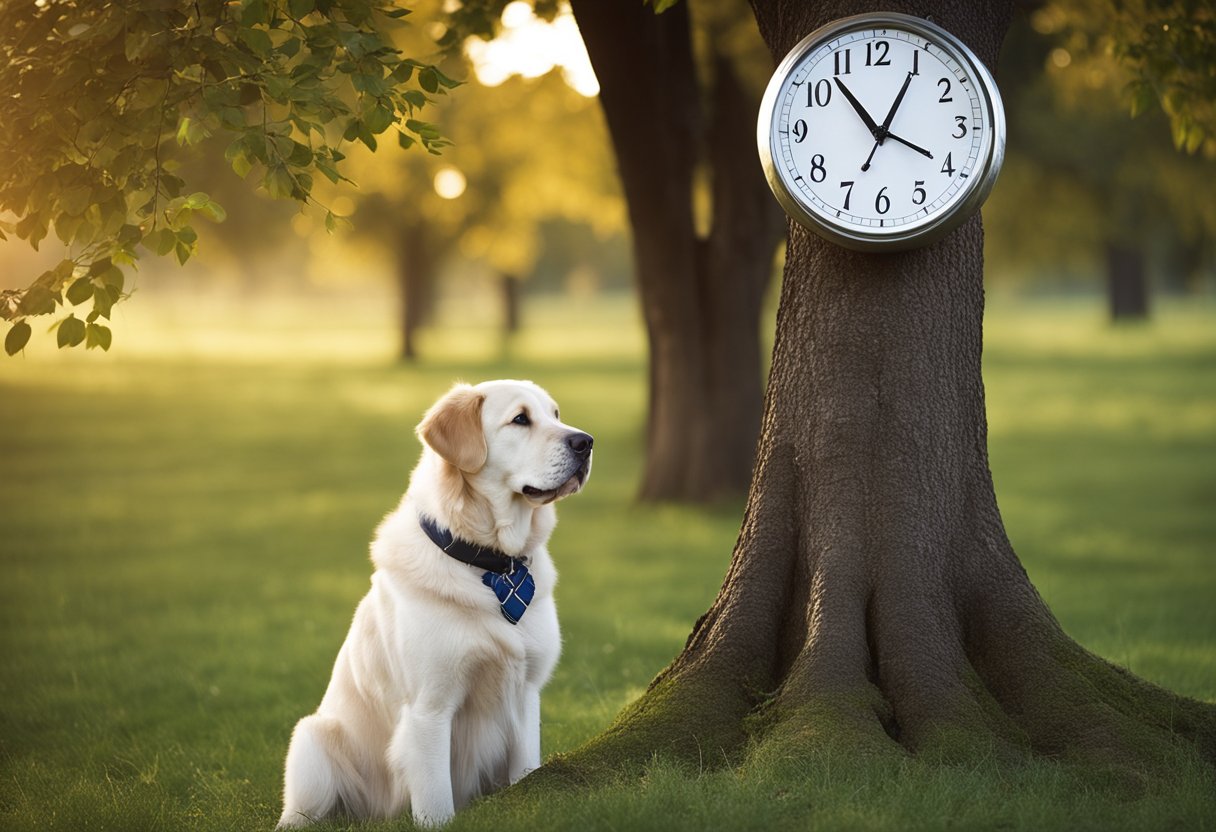
In adult large dogs, the bladder control is quite developed, and typically, they can hold their urine for six to eight hours. Puppies, on the other hand, require more frequent breaks as their bladders are still growing and they are learning control. Older dogs may also need to go out more frequently due to a natural decrease in bladder tone or health issues that affect their urinary systems.
Key Takeaways
- Large dogs can usually hold their urine for 6-8 hours.
- Puppies and senior dogs need more frequent bathroom breaks.
- Multiple factors impact a dog’s bladder control, such as age and health.
Understanding Canine Physiology
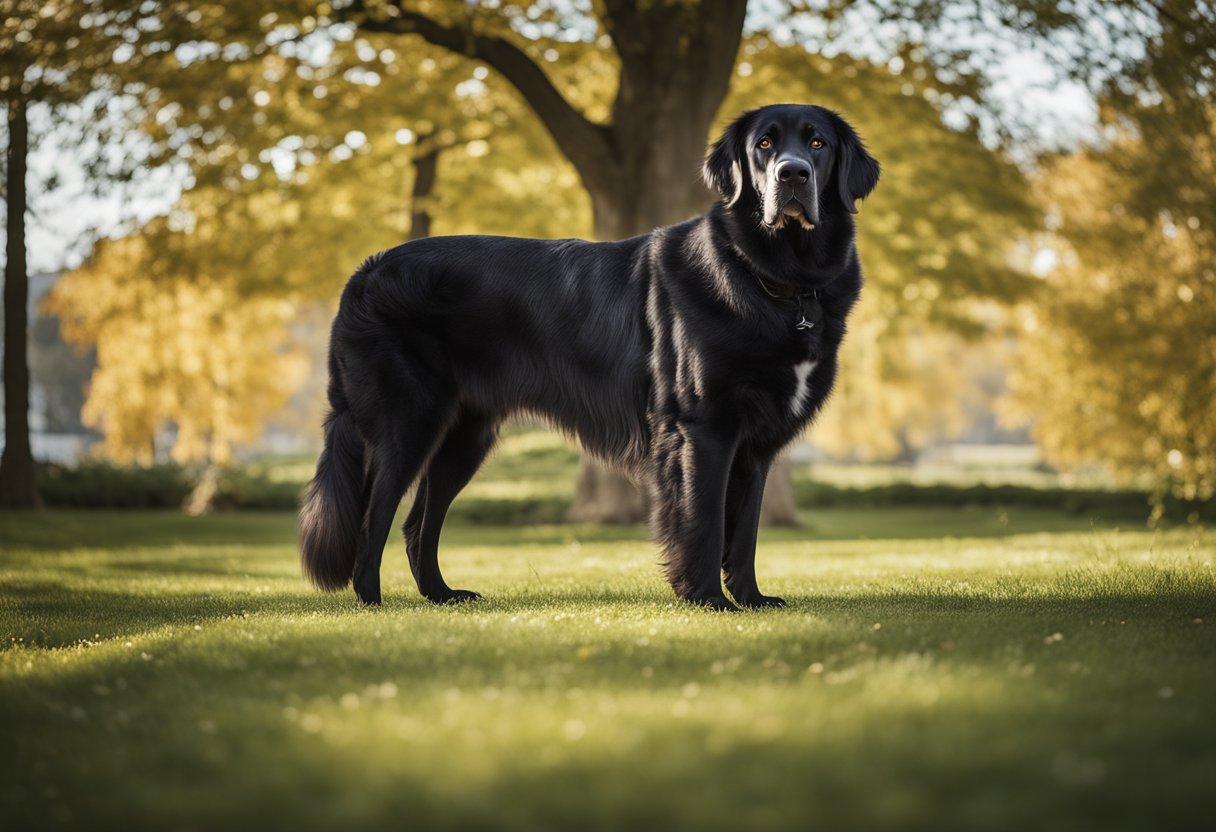
In assessing how long big dogs can hold their pee, one must consider the canine urinary system, which varies across age, breed, and size. These factors directly affect bladder health and capacity, influencing a dog’s ability to control their urine.
The Impact of Age on Bladder Control
Younger dogs, particularly puppies, have less developed urinary systems, resulting in less control and smaller bladder capacity. Puppies can typically hold their pee for one hour for each month of age. Conversely, senior dogs may experience a decrease in bladder control due to the natural aging process, potentially leading to more frequent needs for elimination.
Breed-Specific Bladder Capacities
Some breeds have inherent differences in their bladder sizes, influencing their capacity to hold urine. Smaller breeds often need to urinate more frequently than larger breeds due to their proportional bladder size to body weight. However, larger breeds, while having a bigger bladder, may still face limitations based on their individual health and activity levels.
Size and Body Size Relevance to Bladder Health
The size of a dog greatly impacts the bladder health. As a general rule, a dog’s bladder can hold approximately ½ to 1 cup of urine per 10 pounds of body weight. It’s crucial to consider that this capacity can be influenced by the dog’s overall health and diet. For instance, larger dogs with larger frames can typically hold more, but only to the extent that their health and age permit.
Factors Affecting Urination Frequency
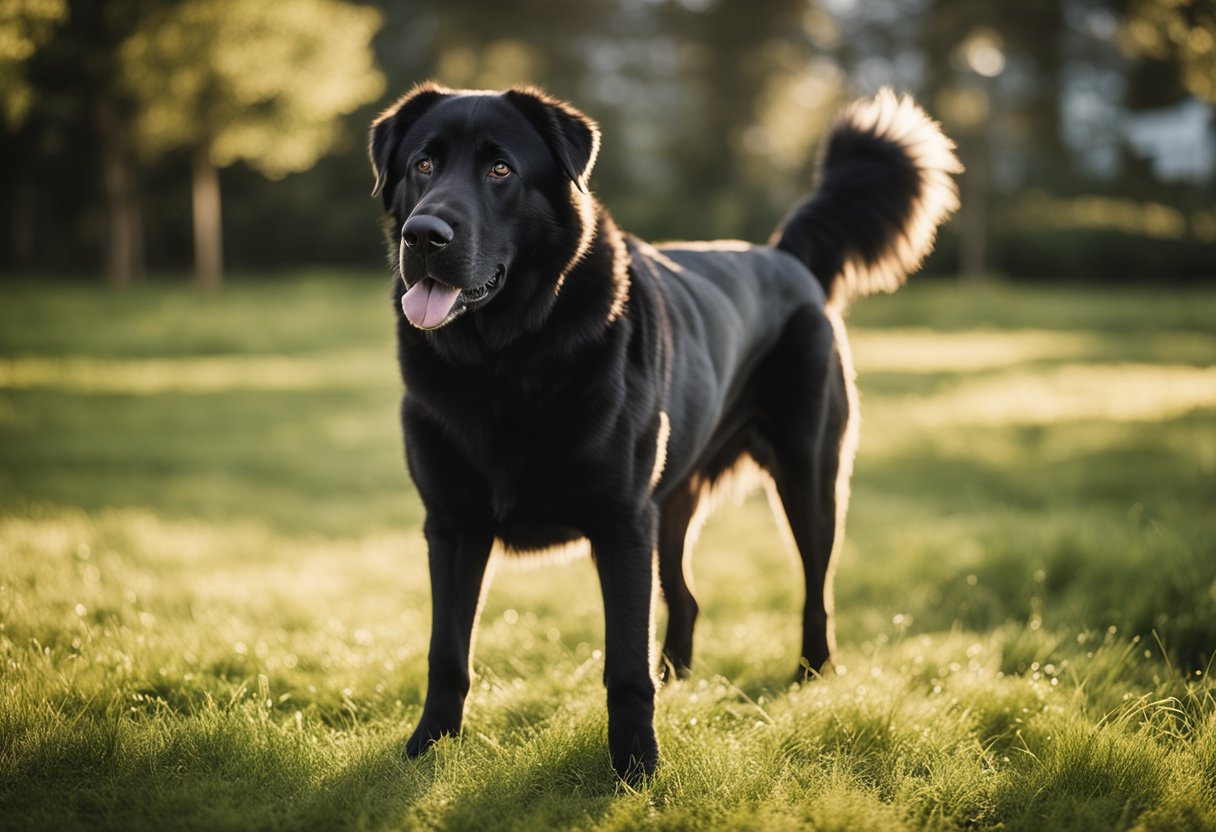
Factors such as health conditions, diet, and physical activity play a crucial role in how frequently a big dog may need to urinate. Understanding these factors can help pet owners manage and maintain their dog’s urinary health.
Health Conditions and Urinary Tract Infections
Health issues, particularly urinary tract infections (UTIs), can significantly impact how often a dog needs to go. Dogs with UTIs may urinate more frequently due to irritation and an urgent need to relieve discomfort. Additionally, other health conditions may affect bladder control and result in increased frequency of urination.
Influence of Diet and Water Intake
The diet of a dog directly influences its water intake and urination. A high-sodium diet can cause increased thirst, leading to greater water consumption and, consequently, more frequent urination. Proper hydration is essential for urinary health, but excessive water intake can also lead to more frequent bathroom breaks.
Exercise and Activity Levels
Exercise and overall activity levels impact a dog’s need to urinate. Active dogs tend to hydrate more and therefore may need to relieve themselves more often. Conversely, a sedentary lifestyle can lead to less frequent urination. Regular physical activity is important for maintaining good urinary health by keeping the bladder and other related systems functioning optimally.
Training and Behavior Modification
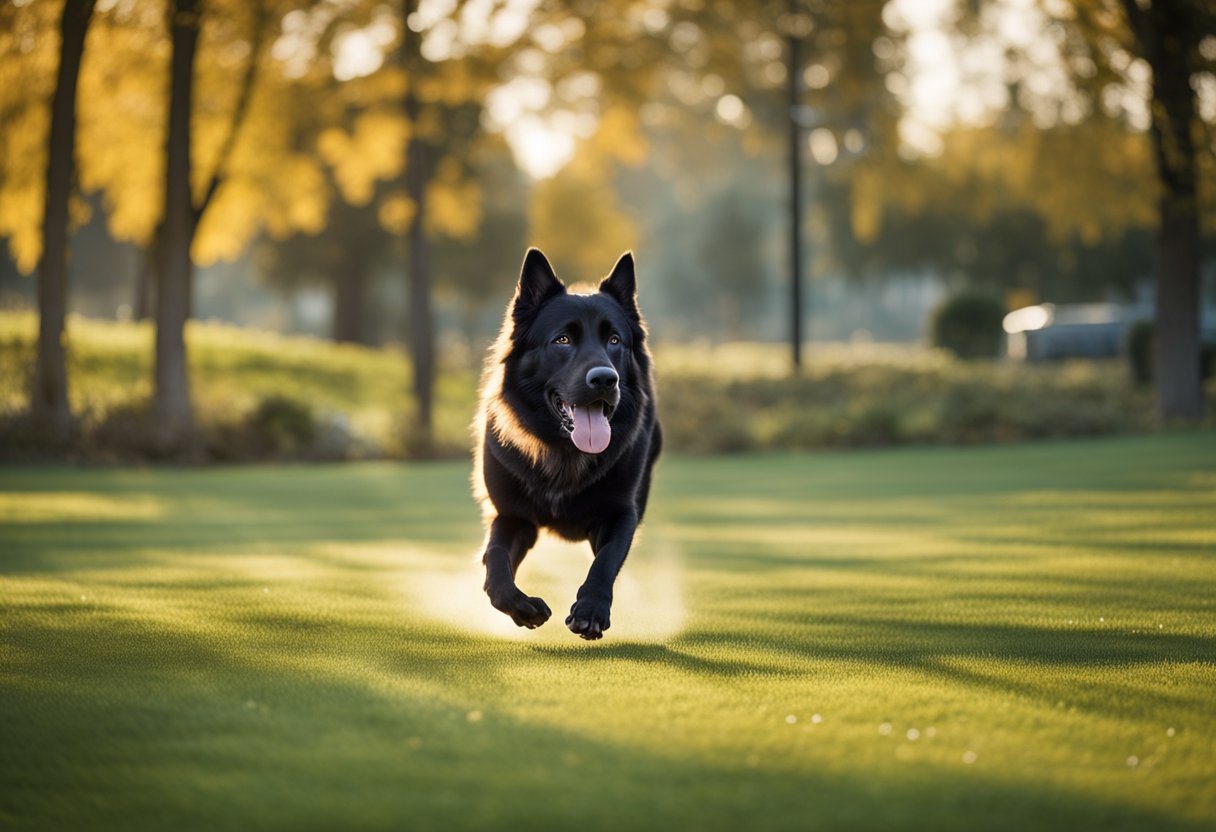
Effective training and behavior modification are crucial for ensuring that both puppies and adult dogs can hold their pee for appropriate durations. This not only contributes to their comfort but also prevents behavioral issues and potential incontinence. A structured approach, combining patience and positive reinforcement, can lead to successful outcomes.
Training Puppies and Adult Dogs for Optimal Comfort
Puppies:
For puppies, the training process takes time, as they can typically hold their bladder for one hour for every month of age. It’s important to establish a regular schedule for bathroom breaks to build their bladder control. The use of positive reinforcement—like treats and praise when they successfully go outside—can enhance their comfort and ensure a positive association with the act of holding their pee and using the appropriate potty area.
- Schedule for Puppies:
- 2 months old: Every 2 hours
- 3 months old: Every 3 hours
- 6 months and older: Every 4-6 hours
Adult Dogs:
Adult dogs generally have more bladder control and can usually last 6-8 hours without a bathroom break. However, they benefit from regular routines and signals that prompt them to relieve themselves at consistent times and locations. Training must be consistent and adjustments made for the individual dog’s comfort and health.
Addressing Behavioral Issues and Incontinence
Behavioral Issues:
Behavioral issues in dogs, such as urinating indoors, may arise from anxiety, lack of proper house-training, or territorial marking. Address these issues by identifying their root causes and employing behavior modification strategies. Consistency and patience from the owner are vital in retraining efforts, and if necessary, professional help from a dog behaviorist should be sought.
Incontinence:
Incontinence in dogs could be a sign of underlying health problems and requires veterinary consultation. Once medical reasons are ruled out or addressed, behavioral training to manage incontinence may involve creating a more frequent bathroom schedule. Using waterproof dog beds and pee pads can also help to manage accidents and maintain the dog’s comfort.
By carefully understanding and addressing the nuances of training and behavior in both puppies and adult dogs, owners can help ensure their pets remain comfortable and well-adapted to the routines of their home.
Managing Your Dog’s Need to Urinate
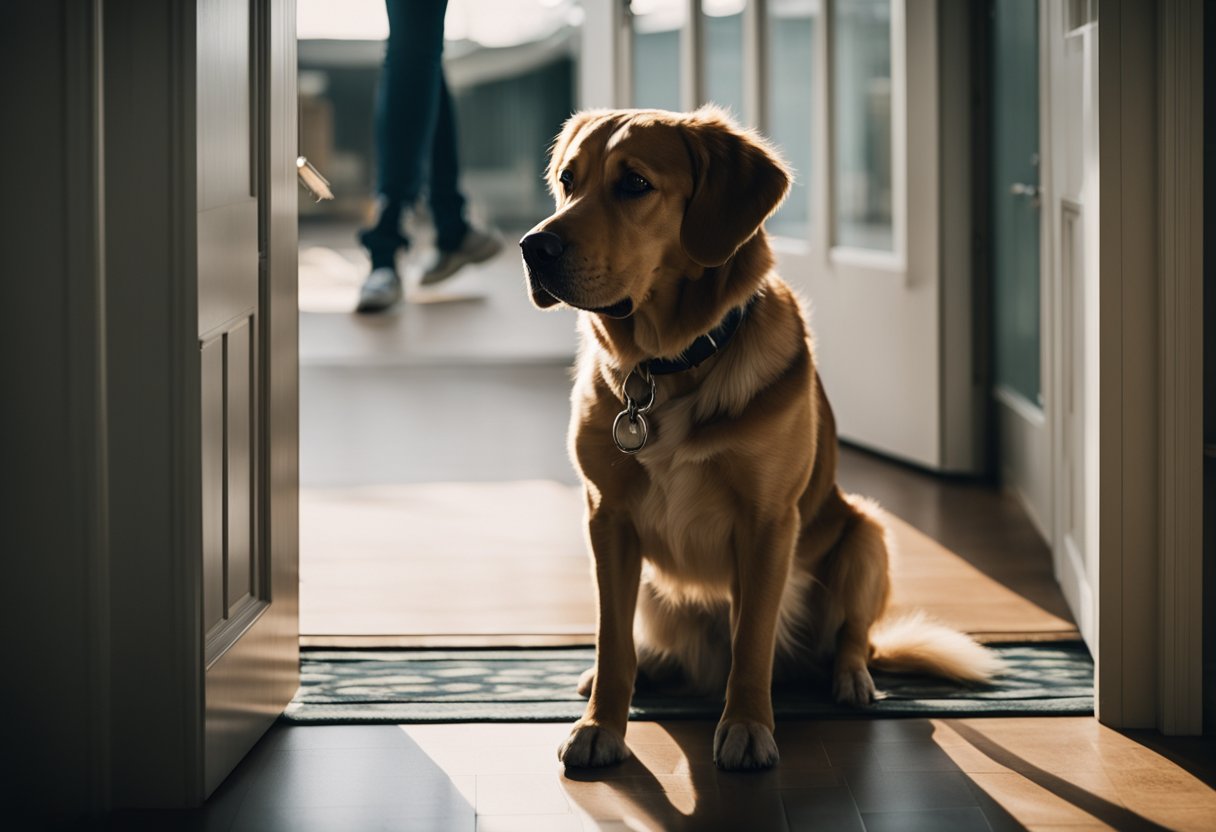
Effective management of your dog’s urination is crucial, especially for larger breeds. Ensuring they are comfortable and avoiding potential health issues requires a balance of regular outdoor trips and indoor solutions.
Creating a Regular Bathroom Break Schedule
Frequency of Breaks:
Dogs generally require potty breaks at regular intervals. Larger dogs can often hold their urine longer than smaller breeds, but it’s essential for dog owners to establish a routine that allows their dogs to relieve themselves at least every 6-8 hours. Identifying your dog’s specific needs could involve monitoring their signals and adjusting the schedule accordingly.
- Morning: Begin the day with a bathroom break to set a consistent routine.
- Midday: If feasible, schedule a break around the middle of the day.
- Evening: Ensure they have the opportunity to go outside before bedtime.
Note for Dog Owners: Busy schedules might interfere with these ideal potty break times, which is where alternative solutions like pee pads or dog walkers become valuable.
Utilizing Aids Like Pee Pads and Dog Walkers
Pee Pads:
For those times when an outdoor break isn’t possible, pee pads can serve as an indoor option:
- Placement: Choose a consistent spot for the pee pad to avoid confusion.
- Size and Absorbency: Select a pad size appropriate for a larger dog to ensure comfort and prevent overflow.
Dog Walkers:
Hiring a dog walker is another strategy to manage your dog’s bathroom needs, promoting exercise and socialization as well:
- Selection Criteria: Consider experience, reliability, and rapport with your dog.
- Schedule: Coordinate with the dog walker to fill gaps in your dog’s potty break routine.
Crate Considerations: If you use a crate, remember that dogs instinctively avoid soiling their sleeping area. However, forcing them to hold their urine for too long by crating can lead to discomfort and potential health issues. Regular breaks are essential to prevent these risks.
Health Considerations and Professional Advice
Big dogs typically have a solid ability to control their bladder, but certain health considerations can affect how long they can hold their urine. Veterinarians play a crucial role in identifying and managing any underlying health conditions that could compromise a dog’s bladder control.
Recognizing Symptoms of Bladder Stones and Infections
Bladder stones in dogs can cause discomfort and an urgent need to urinate. Owners should be attentive to symptoms such as blood in the urine, straining to urinate, or frequent urination. Infections may present with similar symptoms, including lethargy or changes in urinary habits. Persistent symptoms warrant immediate veterinarian attention.
When to Consult a Veterinarian
A veterinarian should be consulted if there are any signs of health problems. This includes changes in the frequency of urination, discomfort during urination, or accidents in the house. If bladder stones or cancer are suspected, the veterinarian may perform diagnostic tests such as urinalysis, X-rays, or ultrasound. Early detection of these health conditions is key to effective treatment and management.
Special Considerations for Senior Dogs
As dogs reach their senior years, they may experience health changes that affect how long they can hold their urine. It’s essential to be aware of these to maintain their comfort and health.
Navigating Age-Related Changes in Urination
Senior dogs often face various age-related changes that can influence their urination patterns. These changes may lead to a reduced capacity to hold urine and an increased frequency of accidents in the house. Understanding and adapting to these changes is pivotal for the well-being of a senior dog.
First, note that a senior dog’s metabolism and body functions slow down, which can impact bladder control and lead to more frequent urination. Additionally, health issues such as diabetes, kidney disease, or urinary tract infections—which are more common in senior dogs—can also affect their ability to hold their pee.
Owners should watch for signs of increased urgency or frequency in urination, as these could indicate underlying health problems. Regular vet check-ups are central to early detection and treatment of these issues, ensuring senior dogs maintain a good quality of life.
Assisting senior dogs with bladder management may involve:
- Offering more frequent potty breaks to accommodate their reduced capacity
- Creating an easily accessible, comfortable area for them to relieve themselves, especially if they experience joint pain or mobility issues
Awareness of these factors helps in preventing discomfort and accidents, allowing senior dogs to age with dignity and as much independence as possible.
Prevention and Resolution of Accidents
Accidents can be a challenge for big dog owners, but understanding and addressing specific behaviors like excitement or submission urination can aid in preventing unwanted incidents in the house. It’s important for owners to observe their dog’s behavior and provide consistent training to maintain a clean environment.
Identifying and Responding to Excitement or Submission Urination
Excitement urination occurs when dogs are overly enthusiastic or happy and lose control of their bladder. To prevent accidents due to excitement, owners should:
- Keep greetings low-key to avoid over-stimulation.
- Gradually expose their dog to exciting situations and reward calm behavior.
Submission urination is a dog’s instinctive response to demonstrate subservience, often occurring during interactions with people or other dogs. To address and correct this behavior, owners should:
- Avoid direct eye contact and approach their dog from the side.
- Speak in soft tones and avoid punishing the dog for submissive urination, as this can exacerbate the problem.
Observing a dog’s body language can provide cues to potential excitement or submission urination. Owners of a trained dog can reinforce commands and control the environment to prevent such accidents. If an accident in the house does occur, they should clean the area thoroughly to eliminate odors that might attract the dog back to the same spot.
Understanding and Responding to Signals
Recognizing when a large dog needs to relieve itself is crucial in preventing accidents and maintaining canine health. Responsiveness to a dog’s communication helps in understanding its needs.
Interpreting Dog’s Communication for Urination Cues
Dogs exhibit specific behaviors when they need to urinate, and owners should be attentive to these signs. For example, a dog may start whining, which is a vocal indication of restlessness or the need to go outside. Another common behavior is sniffing the ground incessantly; this is a dog’s way of searching for an appropriate spot to relieve itself.
Further signs include circling or pacing, which are physical demonstrations of a dog’s urgent need. Observing a change in behavior such as increased agitation or seeming distracted can also signify that it’s time for a potty break. Understanding these dog behavior cues is essential for timely and effective response.
Proactive Approaches to Urinary Health
Ensuring that a big dog can comfortably hold their pee and maintain urinary health requires attention to their hydration needs and awareness of the health risks of holding urine for extended periods.
Ensuring Adequate Hydration and Access to Water
Big dogs need consistent access to clean water to maintain healthy hydration levels and support their bladder capacities. Water intake directly influences urination frequency; therefore, they should always have water available to prevent dehydration. Monitoring their water consumption can help guardians to gauge when their dogs may need to relieve themselves, balancing the needs for holding pee against opportunities to urinate.
Health Risks Linked to Holding Urine Too Long
Holding pee for too long can be detrimental to a dog’s well-being. It may lead to urinary tract infections, bladder stones, or even more severe conditions such as kidney problems. Health risks associated with infrequent urination include discomfort and stress, which can affect a dog’s overall well-being. Guardians should encourage routine bathroom breaks, ideally every 6-8 hours, to mitigate these risks.
Supporting Strategies for Dog Owners
To mitigate health risks and enhance comfort, dog owners bear a crucial responsibility in managing their canine’s urination schedule.
The Role of Dog Owners in Managing Urination
Dog owners have the unique responsibility of balancing their dog’s health with their daily routines. Here are specific strategies they can employ:
- Consistency is key: Establishing a regular bathroom schedule helps dogs hold their pee for predictable periods.
- Monitor water intake: By ensuring their dog has access to fresh water yet moderates intake before bedtime, the risks of accidents or health issues are minimized.
- Evaluate the environment: A dog’s living space should be comfortable and conducive to regular bathroom breaks; a confined space can lead to undesired behavior.
- Health considerations: Staying vigilant about any changes in a dog’s urination patterns can be an early indicator of health problems that may require attention or antibiotics.
- Solution-oriented approach: Dog owners should be proactive in seeking solutions if their dog struggles with holding urine; this may include consulting a veterinarian to rule out any underlying health issues.
- Be patient and supportive: Training takes time, and punishment for accidents can cause stress, which could exacerbate health risks.
By adopting these strategies, dog owners ensure they meet their furry friend’s physiological needs while preventing potential health complications.
Medical Issues and Advanced Care
In managing medical issues such as incontinence or bladder cancer among large breed canines, pet owners should be vigilant in observing symptoms and seeking prompt veterinary care. The health and well-being of senior dogs often require a keen understanding of the potential medical complications that can develop as they age.
Addressing Urinary Incontinence
Urinary incontinence, the loss of bladder control, can be particularly challenging for large breed senior dogs. It is a condition that often arises due to a dog’s advancing age or underlying medical conditions. Veterinarians can prescribe medications that improve bladder muscle tone and control. For instance, hormonal replacement therapies are sometimes effective for spayed females experiencing incontinence. In addition, pet owners can take practical steps to manage incontinence at home by using dog diapers or waterproof bedding to ensure comfort and hygiene.
Bladder Cancer
Bladder cancer, while less common, is a serious condition that can impact large dogs. Symptoms may include difficulties in urination, visible blood in the urine, and frequent urination. It’s imperative to consult with a veterinarian if these symptoms are observed. Advanced care for bladder cancer might involve a combination of treatments such as surgery, chemotherapy, or radiation, depending on the stage and severity of the cancer. Early detection and intervention are crucial in improving the outcomes for dogs with this medical issue.
Frequently Asked Questions
This section addresses common queries about the urinary habits of large breed dogs, focusing on duration, size comparison, influencing factors, nightly habits, health implications, and recommended frequency for urination.
What is the maximum amount of time a large breed dog can safely hold its urine?
A healthy adult large breed dog can typically hold their bladder for about 8 to 10 hours. However, veterinarians often advise against exceeding 6 hours between bathroom breaks to ensure comfort and health.
Are large dogs able to hold their urine for longer periods than smaller breeds?
The capacity to hold urine can vary between breeds; larger dogs generally have a greater bladder capacity in comparison to smaller breeds. Yet, individual factors such as age and health also play a significant role.
What factors influence how long a big dog can wait before needing to urinate?
Numerous elements determine how long a large dog can wait, including age, health status, breed, diet, and training. Environmental aspects and the individual dog’s daily routine also influence the frequency of urination.
Is it safe for a large dog to refrain from urinating overnight, potentially for up to 12 hours?
While some large dogs can hold their bladder overnight, typically up to 8 hours, it is not generally recommended for them to go without a bathroom break for 12 hours. Such extended periods can be uncomfortable and potentially harmful.
What are the potential health risks for big dogs that hold their urine for extended periods?
Prolonged periods without urination can lead to urinary tract infections, bladder stones, or even more severe conditions like urinary incontinence or kidney damage. Ensuring regular bathroom breaks is critical to a large dog’s urinary health.
How often should a large dog ideally be given the opportunity to urinate throughout the day?
Veterinarians generally recommend that dogs be allowed to relieve themselves at least once every 6-8 hours. For the welfare of the dog, consistently providing opportunities three to four times per day is ideal.

